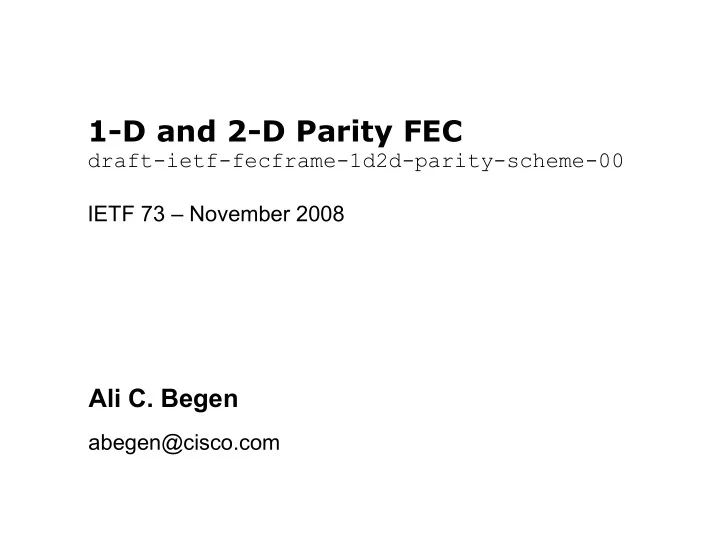

1-D and 2-D Parity FEC draft-ietf-fecframe-1d2d-parity-scheme-00 IETF 73 – November 2008 Ali C. Begen abegen@cisco.com
Introduction • 1-D and 2-D parity codes are systematic FEC codes of decent complexity that provide protection against – Bursty losses – Random losses • This document – Describes the 1-D and 2-D parity codes – Specifies the RTP payload format for these codes • Full RTP compliance with NO backward compatibility with existing specs 2 Ali C. Begen (abegen@cisco.com)
1-D and 2-D Parity FEC • Source block size: D x L L • 1-D Column FEC (for Bursty Losses) – Each column produces a single 1 2 3 R1 Repair Packets packet 4 5 6 R2 – Overhead = 1 / D XOR D – L-packet duration should be larger 7 8 9 R3 than the (target) burst duration 10 11 12 R4 • 1-D Row FEC (for Random Losses) XOR – Each row produces a single packet – Overhead = 1 / L C1 C2 C3 • 2-D (Column + Row) FEC – Overhead = (D+L) / (DxL) Repair Packets 3 Ali C. Begen (abegen@cisco.com)
1-D and 2-D Parity FEC Limitations XOR XOR XOR 1-D Column FEC fails! Both 1-D and 2-D XOR 1-D Row FEC would work FEC fails! 1-D Row FEC fails! 1-D Column FEC would work Packet Loss 4 Ali C. Begen (abegen@cisco.com)
RTP Header 0 1 2 3 0 1 2 3 4 5 6 7 8 9 0 1 2 3 4 5 6 7 8 9 0 1 2 3 4 5 6 7 8 9 0 1 +-+-+-+-+-+-+-+-+-+-+-+-+-+-+-+-+-+-+-+-+-+-+-+-+-+-+-+-+-+-+-+-+ | V=2 | P | X | CC | M | PT | Sequence number | +-+-+-+-+-+-+-+-+-+-+-+-+-+-+-+-+-+-+-+-+-+-+-+-+-+-+-+-+-+-+-+-+ | Timestamp | +-+-+-+-+-+-+-+-+-+-+-+-+-+-+-+-+-+-+-+-+-+-+-+-+-+-+-+-+-+-+-+-+ | Synchronization source (SSRC) identifier | +=+=+=+=+=+=+=+=+=+=+=+=+=+=+=+=+=+=+=+=+=+=+=+=+=+=+=+=+=+=+=+=+ | Contributing source (CSRC) identifiers | | .... | +-+-+-+-+-+-+-+-+-+-+-+-+-+-+-+-+-+-+-+-+-+-+-+-+-+-+-+-+-+-+-+-+ • M bit: Not used, set to 0 • PT: Two types are introduced in this document – Interleaved (column) and non-interleaved (row) – Requires IANA registration • Sequence number: One higher for each subsequent packet • Timestamp: Set to the time corresponding to the transmission time • SSRC: Randomly assigned per RFC 3550 – Sender can multiplex the source and repair flows on the same port, or multiple repair flows on a single port – RTCP CNAME field is used to associate the repair flows with the source flow 5 Ali C. Begen (abegen@cisco.com)
FEC Header 0 1 2 3 0 1 2 3 4 5 6 7 8 9 0 1 2 3 4 5 6 7 8 9 0 1 2 3 4 5 6 7 8 9 0 1 +-+-+-+-+-+-+-+-+-+-+-+-+-+-+-+-+-+-+-+-+-+-+-+-+-+-+-+-+-+-+-+-+ | E | I | P | X | CC | M | PT recovery | SN base | +-+-+-+-+-+-+-+-+-+-+-+-+-+-+-+-+-+-+-+-+-+-+-+-+-+-+-+-+-+-+-+-+ | TS recovery | +-+-+-+-+-+-+-+-+-+-+-+-+-+-+-+-+-+-+-+-+-+-+-+-+-+-+-+-+-+-+-+-+ | Length recovery | Padding | +-+-+-+-+-+-+-+-+-+-+-+-+-+-+-+-+-+-+-+-+-+-+-+-+-+-+-+-+-+-+-+-+ | Padding (optional) | +-+-+-+-+-+-+-+-+-+-+-+-+-+-+-+-+-+-+-+-+-+-+-+-+-+-+-+-+-+-+-+-+ • E bit: Extension flag, set to 0. Reserved for future use • I bit: Set to 0 for 2-byte padding, and 1 for 6-byte padding • P, X, CC, M and PT: Protect the respective fields in the source packets • SN base: Set to the lowest sequence number of those source packets protected by this repair packet • TS recovery: Protects the timestamp of the source packets • Length recovery: Allows FEC to be applied even when the lengths of the protected source packets are not identical 6 Ali C. Begen (abegen@cisco.com)
IANA Registrations • We register the following for audio/video/text/application – non-interleaved-parityfec – interleaved-parityfec • Required Parameters – rate: RTP timestamp (clock) rate – L: Number of columns of the source block – D: Number of rows of the source block – ToP: Type of the protection applied by the sender • 0 for 1-D interleaved FEC protection • 1 for 1-D non-interleaved FEC protection • 2 for 2-D parity FEC protection • 3 is reserved – repair-window (us): Time span of the source and repair packets 7 Ali C. Begen (abegen@cisco.com)
SDP Example v=0 o=ali 1122334455 1122334466 IN IP4 fec.example.com s=2-D Parity FEC Example t=0 0 a=group:FEC S1 R1 R2 m=video 30000 RTP/AVP 100 c=IN IP4 224.1.1.1/127 a=rtpmap:100 MP2T/90000 a=mid:S1 m=application 30000 RTP/AVP 110 c=IN IP4 224.1.2.1/127 a=rtpmap:110 interleaved-parityfec/90000 a=fmtp:110 L:5; D:10; ToP:2; repair-window: 200000 a=mid:R1 m=application 30000 RTP/AVP 111 c=IN IP4 224.1.2.2/127 a=rtpmap:111 non-interleaved-parityfec/90000 a=fmtp:111 L:5; D:10; ToP:2; repair-window: 200000 a=mid:R2 8 Ali C. Begen (abegen@cisco.com)
Next Steps • Work with SMPTE and complete this work 9 Ali C. Begen (abegen@cisco.com)
Recommend
More recommend